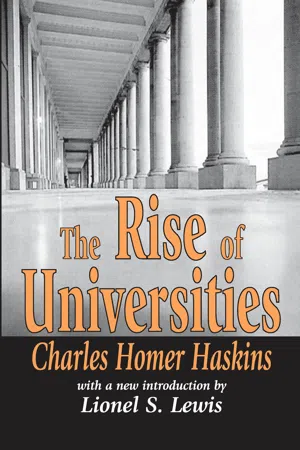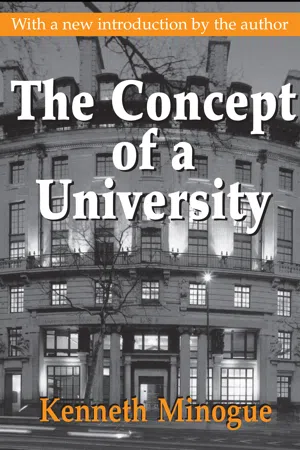History
University of Bologna
The University of Bologna, established in 1088, is considered the oldest university in the Western world. It played a significant role in the development of medieval and Renaissance legal studies and is renowned for its contributions to the field of law. The university continues to be a leading institution for academic research and education.
Written by Perlego with AI-assistance
Related key terms
3 Key excerpts on "University of Bologna"
- eBook - ePub
- Charles Homer Haskins(Author)
- 2013(Publication Date)
- Cornell University Press(Publisher)
licence. A Master of Arts was one qualified to teach the liberal arts; a Doctor of Laws, a certified teacher of law. And the ambitious student sought the degree and gave an inaugural lecture, even when he expressly disclaimed all intention of continuing in the teaching profession. Already we recognize at Bologna the standard academic degrees as well as the university organization and well-known officials like the rector.Other subjects of study appeared in course of time, arts, medicine, and theology, but Bologna was preeminently a school of civil law, and as such it became the model of university organization for Italy, Spain, and southern France, countries where the study of law has always had political and social as well as merely academic significance. Some of these universities became Bologna’s competitors, like Montpellier and Orleans as well as the Italian schools nearer home. Frederick II founded the University of Naples in 12 24 so that the students of his Sicilian kingdom could go to a Ghibelline school at home instead of the Guelfic centre in the North. Rival Padua was founded two years earlier as a secession from Bologna, and only in 1922, on the occasion of Padua’s seven-hundredth anniversary, I saw the ancient feud healed by the kiss of peace bestowed on Bologna’s rector amid the encores of ten thousand spectators. Padua, however, scarcely equalled Bologna in our period, even though at a later age Portia sent thither for legal authority, and though the university still shines with the glory of Galileo.In northern Europe the origin of universities must be sought at Paris, in the cathedral school of Notre-Dame. By the beginning of the twelfth century in France and the Low Countries learning was no longer confined to monasteries but had its most active centres in the schools attached to cathedrals, of which the most famous were those of Liège, Rheims, Laon, Paris, Orleans, and Chartres. The most notable of these schools of the liberal arts was probably Chartres, distinguished by a canonist like St. Ives and by famous teachers of classics and philosophy like Bernard and Thierry. As early as 991 a monk of Rheims, Richer, describes the hardships of his journey to Chartres in order to study the Aphorisms - eBook - ePub
- Charles Homer Haskins(Author)
- 2017(Publication Date)
- Routledge(Publisher)
licence. A Master of Arts was one qualified to teach the liberal arts ; a Doctor of Laws, a certified teacher of law. And the ambitious student sought the degree and gave an inaugural lecture, even when he expressly disclaimed all intention of continuing in the teaching profession. Already we recognize at Bologna the standard academic degrees as well as the university organization and well-known officials like the rector.Other subjects of study appeared in course of time, arts, medicine, and theology, but Bologna was preeminently a school of civil law, and as such it became the model of university organization for Italy, Spain, and southern France, countries where the study of law has always had political and social as well as merely academic significance. Some of these universities became Bologna’s competitors, like Montpellier and Orleans as well as the Italian schools nearer home. Frederick II founded the University of Naples in 1224 so that the students of his Sicilian kingdom could go to a Ghibelline school at home instead of the Guelfic centre in the North. Rival Padua was founded two years earlier as a secession from Bologna, and only last year, on the occasion of Padua’s seven-hundredth anniversary, I saw the ancient feud healed by the kiss of peace bestowed on Bologna’s rector amid the encores of ten thousand spectators. Padua, however, scarcely equalled Bologna in our period, even though at a later age Portia sent thither for legal authority, and though the university still shines with the glory of Galileo.In northern Europe the origin of universities must be sought at Paris, in the cathedral school of Notre-Dame. By the beginning of the twelfth century in France and the Low Countries learning was no longer confined to monasteries but had its most active centres in the schools attached to cathedrals, of which the most famous were those of Liège, Rheims, Laon, Paris, Orleans, and Chartres. The most notable of these schools of the liberal arts was probably Chartres, distinguished by a canonist like St. Ives and by famous teachers of classics and philosophy like Bernard and Thierry. As early as 991 a monk of Rheims, Richer, describes the hardships of his journey to Chartres in order to study the Aphorisms - eBook - ePub
- Kenneth Minogue(Author)
- 2017(Publication Date)
- Routledge(Publisher)
universitas, a term which might be used of any kind of legal association; towards the end of the Middle Ages it was coming to be restricted to what we now call universities. This organizational character of universities is in a number of respects just as important as their intellectual distinction, for it is here that we may find the secret of that astonishing longevity, that capacity for decay and revival which has marked the university out as distinct from any of the other scholarly institutions of other times and other civilizations. Universities were, as Rashdall puts it, ‘products of that instinct of association which swept like a great wave over the towns of Europe in the course of the eleventh and twelfth centuries’. And for several centuries, until political sovereignty began to impair their independence, they exercised the corporate freedom of feudalism to the full.Spontaneity soon gave place to artifice: in 1224 (by which time many other universities, including Oxford, were well established) Frederick II founded a studium generale in Naples, and in 1229 Pope Gregory IX did the same at Toulouse. The intention of each of these eminent founders was that the new creations should be the equals in prestige of Paris and Bologna; and in an attempt to achieve by decree what is really only susceptible to voluntary acquiescence, a Papal bull of 1233 asserted that anyone admitted to mastership at Toulouse should be allowed to teach in any other studium without further examination. The bull did not meet with universal acceptance, and the more successful studia were always suspicious of the prerogatives of other universities. Nonetheless, the granting of the ius ubique docendi came to be the distinguishing mark of universities; and founding them was recognized as the prerogative of imperial or ecclesiastical authority. By this time, their intellectual eminence gave them an important role in the life of European Christendom. Intellectually able young men of all ranks of society flocked to study at them, and many such graduates, after studying, came to occupy influential positions in the Church and the administration of realms. There were even occasions when medieval writers placed Studium as a co-ordinate power in medieval society alongside the powers of Church (Sacerdotium) and State (Regnum).
Learn about this page
Index pages curate the most relevant extracts from our library of academic textbooks. They’ve been created using an in-house natural language model (NLM), each adding context and meaning to key research topics.


